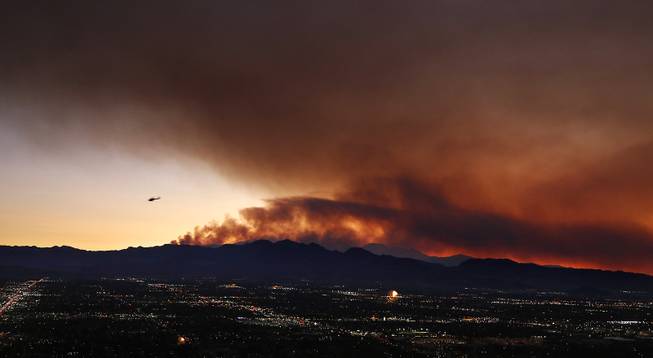
Smoke from the Mount Charleston fire is seen during sunset in Las Vegas on Tuesday, July 9, 2013.
Published Wednesday, July 10, 2013 | 5:55 p.m.
Updated Thursday, July 11, 2013 | 10:06 a.m.
A relieving bout of summer rain has prompted Clark County to downgrade an air-quality alert to an advisory.
In a news release Thursday, Clark County spokesman Erik Pappa said the combination of moisture in the atmosphere and a change in directional flow has led to a decrease in smoke levels in the Las Vegas Valley caused by the wildfire on Mount Charleston.
Clark County Department of Air Quality originally issued the alert Wednesday because of rising levels of unhealthy air pollution, also known as particulate matter, stemming from the 10-day-old.
Russell Roberts, the department’s principal air-quality specialist, said the rainy forecast could help disperse the air pollution.
Roberts said the northwest and west sides of the valley were getting the highest levels of smoke and high-level particulates because of their proximity to the fire.
But the amount of particulate matter in the air over Clark County didn't get as bad as officials expected on Wednesday. There was no exceeding of levels dictated by the federal Clean Air Act.
"When you violate that, not only do you have a health issue, but you have a legal issue," said Roberts, adding that there are provisions in the act for special circumstances, like wildfires.
The particulate matter in the air is "so small you can (breathe) it into your lungs."
He noted that larger, visible falling ash from the fire was more of an annoyance than a potential health issue.
"From a health perspective, ash isn't an issue. Ash just makes things dirty," said Roberts, who added that ash is usually too large to be inhaled.
Dr. Joel Katz, a Las Vegas allergy, asthma and immunology physician, said the number of patients visiting his practice has grown as the wildfire has spread.
"We've been seeing more people since July 5," said Katz, whose patients reported symptoms such as shortness of breath, wheezing and eye irritation.
Katz said individuals who have asthma, allergies or other respiratory problems are more sensitive to pollution in the air. But the smoke also could negatively affect people who don’t have a diagnosed respiratory issue, he said.
"You have increased particulate materials from all the ash and the soot, and when those are inhaled, they're going to give rise to asthma-like symptoms," Katz said.
To avoid breathing in pollutants, people can take precautions including limiting outdoor activities.
"Limit your exposure. Use air conditioning, both in the car and in the house. If you're having any shortness of breath, you need to see a physician," Katz said.
Roberts echoed Katz's advice. He added that if an individual with prior respiratory issues has to stay outside for long periods, using a high-efficiency particulate air (HEPA) mask could help.

Join the Discussion:
Check this out for a full explanation of our conversion to the LiveFyre commenting system and instructions on how to sign up for an account.
Full comments policy